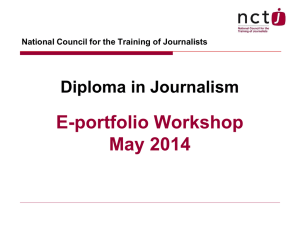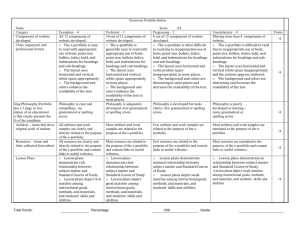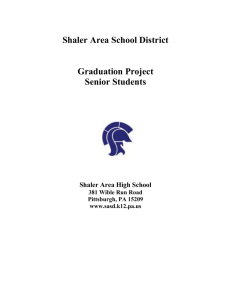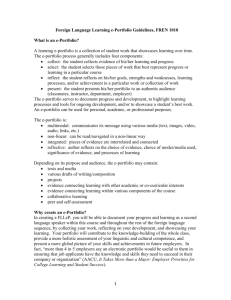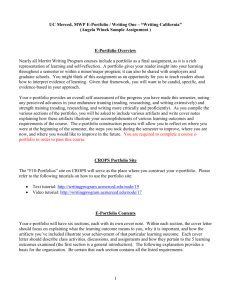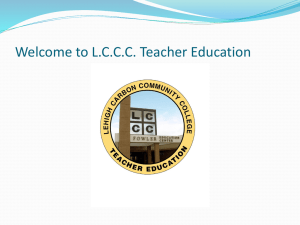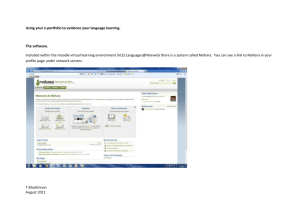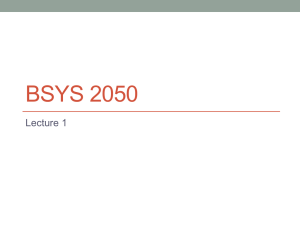E-Portfolio for Developing Teacher Assessment and Self
advertisement
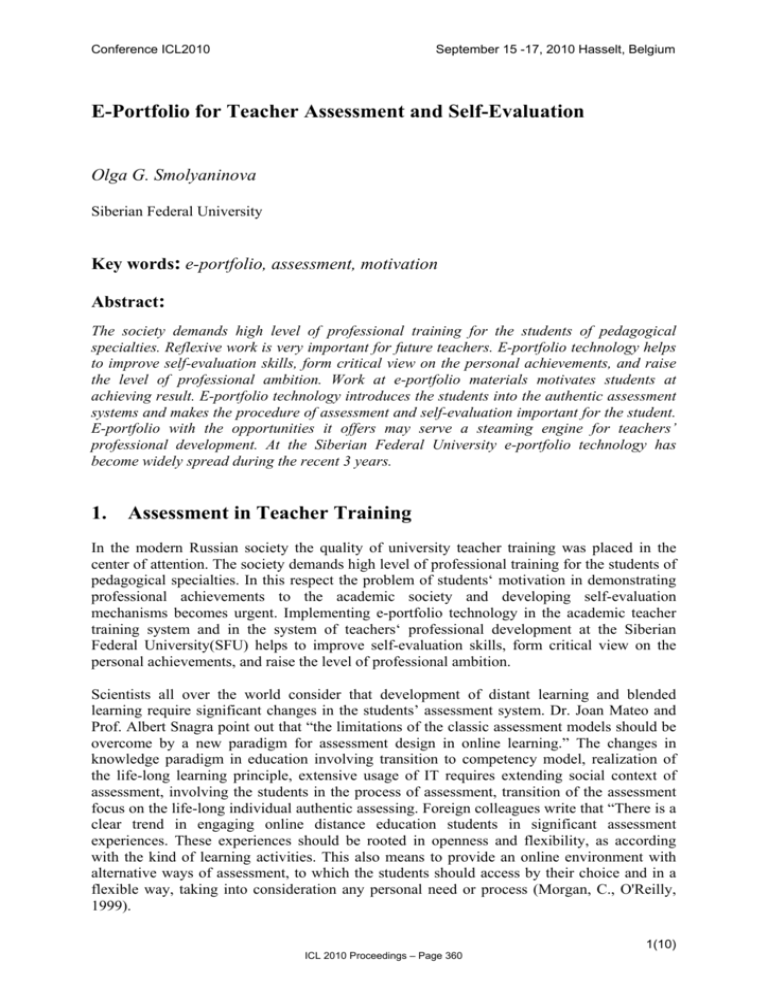
Conference ICL2010 September 15 -17, 2010 Hasselt, Belgium E-Portfolio for Teacher Assessment and Self-Evaluation Olga G. Smolyaninova Siberian Federal University Key words: e-portfolio, assessment, motivation Abstract: The society demands high level of professional training for the students of pedagogical specialties. Reflexive work is very important for future teachers. E-portfolio technology helps to improve self-evaluation skills, form critical view on the personal achievements, and raise the level of professional ambition. Work at e-portfolio materials motivates students at achieving result. E-portfolio technology introduces the students into the authentic assessment systems and makes the procedure of assessment and self-evaluation important for the student. E-portfolio with the opportunities it offers may serve a steaming engine for teachers’ professional development. At the Siberian Federal University e-portfolio technology has become widely spread during the recent 3 years. 1. Assessment in Teacher Training In the modern Russian society the quality of university teacher training was placed in the center of attention. The society demands high level of professional training for the students of pedagogical specialties. In this respect the problem of students‘ motivation in demonstrating professional achievements to the academic society and developing self-evaluation mechanisms becomes urgent. Implementing e-portfolio technology in the academic teacher training system and in the system of teachers‘ professional development at the Siberian Federal University(SFU) helps to improve self-evaluation skills, form critical view on the personal achievements, and raise the level of professional ambition. Scientists all over the world consider that development of distant learning and blended learning require significant changes in the students’ assessment system. Dr. Joan Mateo and Prof. Albert Snagra point out that “the limitations of the classic assessment models should be overcome by a new paradigm for assessment design in online learning.” The changes in knowledge paradigm in education involving transition to competency model, realization of the life-long learning principle, extensive usage of IT requires extending social context of assessment, involving the students in the process of assessment, transition of the assessment focus on the life-long individual authentic assessing. Foreign colleagues write that “There is a clear trend in engaging online distance education students in significant assessment experiences. These experiences should be rooted in openness and flexibility, as according with the kind of learning activities. This also means to provide an online environment with alternative ways of assessment, to which the students should access by their choice and in a flexible way, taking into consideration any personal need or process (Morgan, C., O'Reilly, 1999). ICL 2010 Proceedings – Page 360 1(10) Conference ICL2010 2. 2.1. September 15 -17, 2010 Hasselt, Belgium Modern Trends in Assessment Learner-centered approach to assessment In adult education the necessity of changes in the assessment system is especially important. Adults are motivated at reaching educational results and further productive professional activity. M.E.Rossman and M.H.Rossman point out on the necessary relationship between theory and practice: “the pertinence of the assessment activities, real life-based, and useful for the students as learning activities“ (Rossman M.E., Rossman M.H., 1990). Experience of using traditional model of education shows that students get accustomed to the formal examination procedure and assessment tests, and soon rating or grades do not motivate them for further educational achievements. S.Braun and P.King admit that “assessment is at the heart of students’ experience” (Brown, S., Kinght P., 1994). According to G. Brown “assessment defines what students regard as important, how they spend their time and how they come to see themselves as students and then as graduates…. If you want to change students’ learning then change the method of assessment” (Brown, G., Pendlebury, M. 1997). In their article they state that shifting the paradigm in assessment is necessary: from tutor-led assessment and implicit criteria to student-led assessment and explicit criteria; from Competition and Object and Content to Collaboration and Outcome and Competences; from product assessment to process assessment. J.Mateo and A.Sangra point out that it is necessary to shift from “assessing academic disciplines to professional competencies” and “from final assessment to continuous assessment” (Mateo, J., Sangra, A., 2007). Until recently the problem of interrelation of qualitative and quantitative assessment is very urgent, as well as the problem of the educational results obtained with the help of measuring tools which are used for students’ development, not for assessment itself. J.Mateo and A.Sangra state that “The classic pretence of measuring has historically consisted in treating to quantify the attributes which are present in objects or individuals. This means that we attempt to standardize and objectify our judgement in respect to these attributes and therefore facilitate their study and knowledge… There is evidence that there are a large number of limitations of which some are conceptual, others instrumental and finally methodological ones as well“ (Mateo, J., Sangra, A., 2007). In our practical work we stick to the so called “assessment for learning” paradigm for involving the teacher into continual monitoring of the pedagogical process, analyzing existing curricular problems and students’ individual problems. We help the students in their learning. That does not mean that the teacher’s assessment of the student’s work should always be positive, that does not mean the teacher offers the solutions, it means that “the teacher can offer support to the student but can never provide solution to the problem” (Mateo, J., Sangra , A., 2007). G.Roberts mentioned that for good assessment the following is essential: sharing of learning objectives and outcomes with students students peer and self assessment feedback to students to inform about the next steps in learning. After many researchers we consider e-portfolio one of the best designed platforms to support instructive processes that could realize new paradigm of “assessment for learning”. ICL 2010 Proceedings – Page 361 2(10) Conference ICL2010 2.2. September 15 -17, 2010 Hasselt, Belgium E-portfolio for assessment and reflection Undoubtedly, еPortfolio is one of the prospective technologies of life-long authentic assessment aimed at self-assessment, self-organization, competency development, career planning and life-long learning. According to F.Paulson, P.Paulson and C.Meyer "Portfolios offer a way of assessing student learning that is different from traditional methods. Portfolio assessment provides the teacher and students an opportunity to observe students in a broader context: taking risks, developing creative solutions, and learning to make judgments about their own performances." „Portfolio consisted in compiling student works that have been gathered throughout his learning process and that offer evidence regarding his knowledge, skills and competences, even regarding him being prepared to act in determined ways“ (Martin, D.J., 1997). J.Mateo and A.Sangra distinguish one key advantage of a portfolio: „it allows the student to present his creations to the teacher so that this one gets a better understanding of the student's work in a global perspective, not fragmented and disconnected of other aspects of his personality” (Mateo, J., Sangra , A., 2007). They underline that e-portfolio is not only the digital container of big diversity amount of information but more than that. „E-portfolio forms a dynamic and comprehensive meeting space for the processes of instructional, evaluative and personal development of the student“ (Barberà, E., Ahumada, M., 2007). E-portfolio technology makes the process of teaching and learning more open and flexible. G.Roberts believes that e-portfolio changes the paradigm of the assessment process (Roberts,G., 2006). The grounds of this paradigm are reciprocity, authenticity, credibility, exemplification, student-tutor contact, student-student cooperation. There are different approaches toward realization of these principles in the system of students’ assessment by means of e-portfolio method. Mindful School web-site (Portfolio connection IRI/ Skylight Publishing, http://www.mindfulschools.org ) offers a teacher “multiple scoring strategies to evaluate students' progress. Criteria for a finished portfolio might include several of the following: “Thoughtfulness (including evidence of students' monitoring of their own comprehension, metacognitive reflection, and productive habits of mind). Growth and development in relationship to key curriculum expectancies and indicators. Understanding and application of key processes. Completeness, correctness, and appropriateness of products and processes presented in the portfolio. Diversity of entries (e.g., use of multiple formats to demonstrate achievement of designated performance standards).” 2.3. The experience of assessing achievements by means of an e-portfolio We studied the experience of assessing achievements by means of an e-portfolio course in social psychology presented at the university web-site wikiversity (http://en.wikiversity.org/wiki/social_psychology/assessment/e-portfolio). The basic goal in using e-portfolio is to provide an ongoing, assessable learning activity which is meant to help students to record, explore, synthesize, and share their learning during the unit. The following marking criteria model is offered: ICL 2010 Proceedings – Page 362 3(10) Conference ICL2010 September 15 -17, 2010 Hasselt, Belgium Regularity/continuity (33.3%). Regularity refers to demonstrating a consistent and continuous engagement throughout the unit. The idea is to encourage and reward ongoing, regular participation in, and reflection upon, the unit's learning activities (e.g., lectures, tutorials, readings, and assessment tasks). Students should provide evidence of engagement (via reflection) across and throughout the unit's learning activities. Depth/insightfulness (66.6%). Depth refers to the extent of one's engagement (thinking, questioning, reading, researching, etc.) in the unit's learning activities. Length/size of contributions may be an indicator, but more important is the quality and depth of demonstrated engagement. The following might be indicative: length, quality, references, links, ideas, opinions, discussion, images etc. In accord with the qualification criteria presented in the table “Distance Course Social psychology in Wikiversity” (http://en.wikiversity.org/wiki/social_psychology/assessment/e-portfolio) students may get one of the 5 grades: HD (high Distinction), DI (Distinction), CR (Credit), P (Pass), F (Fail). Thus, this example demonstrates the opportunities of combining quantitative and qualitative assessment methods within the described academic course on the basis of the artifacts presented in the e-portfolio. In accord with the described above paradigms this one employs competency paradigm of education, and e-portfolio technology allows involving students in the active learning and reflexion, develops self-evaluation skills, motivates to cooperate and provokes topical network discussions. The assessment model is presented to the students at the very beginning of their study, requirements for every criterion are described in detail. The students are involved in the process of achieving a result. E-portfolio technology makes development of reflexive skills very important. This is significant for a future social psychologist. 3. E-portfolio in Training Teachers at the Siberian Federal University (SFU). 3.1. Assessment System of the New Generation Program of development adopted at the Siberian Federal University correlates with the new standards of teacher education for “New School of the 21st Century”. E-portfolio technology has become widely spread during the recent 3 years in the system of professional training of educationalists at SFU. E-portfolio is being used on different levels of teacher training and for many purposes. E-portfolio technology helps young teachers to form reflexive skills and think over professional pedagogical concepts, record the results of practical work, form and develop competencies for planning academic activity and achieving results. United efforts of the team members – enthusiasts from IEPS SFU and the support from the university IT Department led to the successful realization of IREX Grant No. FY09-UASP-Smolyaninova-01 and the Grant from Russian Humanitarian Scientific Fund in 2008-2009. These projects were devoted to eportfolio for professional development of higher school teachers and for assessment purposes. The projects lasted two years, during this period over 60 teachers and 80 students received IT training to develop their individual e-portfolio based on SFU platform. We carried out pilot research work aimed at defining the optimal e-portfolio structure for students, post-degree students, young teachers, and IEPS staff. At present IEPS SFU is implementing this system into the academic practice. Today the IEPS web-site contains more than 180 e-portfolios of ICL 2010 Proceedings – Page 363 4(10) Conference ICL2010 September 15 -17, 2010 Hasselt, Belgium Bachelor program students, Master program students and university teachers. This year teachers’ e-portfolio has been officially included in the university rating system. Teachers’ rating will be calculated on the basis of the information published in e-portfolios (publications, awards, participation in grants and projects, etc.). E-portfolio is used by students for introducing themselves in the virtual university environment. Bachelor students of the 1st year while developing materials for their eportfolios get involved in the reflexive process; they consider their future pedagogical profession, analyze their weak and strong points from the point of view of a future teacher. Eportfolios of Bachelor program students contain the following materials: “Myth about pedagogical profession”, “My pedagogical principles”, “Results of professional orientation game”. Reflexive section of e-portfolio is very important as it helps first-year students to think of and discuss their plans for future, differentiate and declare their position and educational principles. Reflexive work connected with the educational process is very important for future teachers; this reflexive work is easy to start during workshops where every student takes active position. Students also present their opinion on whether other people understand them or not at face-to-face communication. Reflexive section is accessible only for teachers and students of the same group. Teaching staff and students are involved in the process of the students’ development; information is protected by limited access. 3.2. Assessment criteria for student’s e-portfolio (1st year of study) used at IEPS SFU. Credit rating system was introduced into the academic practice at SFU within implementing the Bologna system. Academic programs were revised. Student gets credits in accord with the results of his academic activity. Credits are summed up in the form of rating, the level of the students’ grants and the marks the students get at the examinations also depend on the rating. The students receive scholarships in case they reach upper level in the rating table. The rating is stated in the diplomas. We try to use both qualitative and quantitative assessment methods while assessing individual educational achievements. The assessment system has multi-level structure. From the one hand we assessed students’ e-portfolio using two different types of assessment: Group assessment, after presenting e-portfolio, according to the given assessment criteria; both co-students and experts take part. Competition “The Best Student’s E-portfolio” among students. The best e-portfolio is chosen by experts and graduates. Presenting the student to prospective employees and career development is in the focus of the assessment. There were three winners in this competition, they received premiums and their e-portfolios were published on the web-site. From the other hand we used e-portfolio for involving students into active learning, reflexion process and planning, for organizing feedback from teachers and co-students. We found such practice very useful for the students of the 1st year. E-portfolio technology was used for presenting the students our experience in projecting activity. The artifacts presented in eportfolio were assessed by the subject teacher not only in credit units, the assessment was supported by comments on the students’ works and the works that were carried out in small groups. Below in Table 1 are the criteria of students’ e-portfolio assessment. ICL 2010 Proceedings – Page 364 5(10) Conference ICL2010 September 15 -17, 2010 Hasselt, Belgium Table 1. Students’ e-portfolio assessment criteria N Criterion 1 Selection of Artifacts presented in eArtifacts portfolio should be thoroughly selected and reflect achievements in every sphere (course), be authentic, complete and clear; correlate to the e-portfolio goals, and present individual progress. Design Presented materials and descriptions should be clear and precise, the color and the font should be appropriate and matching the whole picture. The format of the presented materials should correspond the task of making the picture most convincing. Reflection All reflections illustrate the ability to effectively criticize the work and provide constructive practical suggestions. 2 3 Description 4 Use of Skills in using Multimedia multimedia include scanned photos, documents, audio and video materials for presenting educational process and results. 5 Author’s The author’s position Position and should be clearly stated. Creativity The author’s style, creative approach in presenting achievements and self-development is highly evaluated. High distinction (10-8 points) Presented evidence of the learning outcome is authentic, complete, clear, corresponding to the e-portfolio goals and reflects individual progress. Unsatisfactory Points (0-3 points) Most of the __/10 artifacts do not look convincing, are incomplete and do not correspond to eportfolio goals. E-portfolio is easy to read. The fonts, colors, background, point size, bullets, graphs, headings, etc. are best suitable for presenting materials. E-portfolio is __/10 difficult to read due to inappropriate use of fonts, point size, colors, background, bullets, graphs, heading and so on E-portfolio shows the students’ understanding of the learning process, engages the student in reflective dialogue with himself and others. The artifacts demonstrate achieving the goals. Appropriate graphics, audio/video enhance reflective statements, raise interest and serve the example of the student’s IT competency. Absence of __/10 reflections point to the fact that the student has no ability to effectively criticize the work or provide constructive practical suggestions. __/10 Inappropriate graphics, audio/videos do not enhance reflective statements, make negative general impression on the viewer and detract from the content. Creativity and Absence of creative __/10 original ideas enrich or original ideas negative the content of the e- make general impression portfolio. on the viewer and testify to the fact that the student is not competent enough. ICL 2010 Proceedings – Page 365 6(10) Conference ICL2010 September 15 -17, 2010 Hasselt, Belgium N Criterion Description 6 Correct Grammar E-portfolio text and artifacts should be free of grammar mistakes and stylistic drawbacks. 7 Welcome Section 8 9 10 High distinction (10-8 points) E-portfolio text and artifacts are free of grammar mistakes and stylistic drawbacks. Unsatisfactory Points (0-3 points) The text has many __/10 errors in grammar, capitalization, punctuation and spelling. The text requires major editing and revision (more than 6 errors). __/10 E-portfolio welcome section is not thought over, the focus of the presentation is not clear; this section does not serve the formation of the author’s positive image. E-portfolio begins with welcome section. In the very beginning a thorough planning should be done. Special attention should be given to the design as it makes the first impression. The focus of the presentation should be clearly stated. Demonstration E-portfolio should of the key clearly present key IT competencies competencies, social competencies, teamwork competency and competency in critical thinking. E-portfolio welcome section is thought over, the focus of the presentation is clear; it serves the formation of the author’s positive image. Demonstration E-portfolio should of pedagogical contain artifacts competencies presenting the author’s pedagogical position, modern pedagogical practice and assessment models. Urgency E-portfolio is the result of the students’ work and a continuously developing product. The artifacts should be regularly updated, the problems the author dwells upon - urgent for the author and the readers. Total __/10 E-portfolio artifacts do not allow to judge on the level of the student’s pedagogical competencies. __/10 E-portfolio materials E-portfolio are urgent, materials are not interesting, and urgent, interesting, and modern. modern. E-portfolio artifacts allow conclusion that the student has highly developed IT competencies, social competencies, teamwork competency and is competent in critical thinking. E-portfolio artifacts allow to judge on the high level of the student’s pedagogical competencies. ICL 2010 Proceedings – Page 366 __/10 E-portfolio artifacts do not give objective picture of the student’s key competencies and their level. __/100 7(10) Conference ICL2010 September 15 -17, 2010 Hasselt, Belgium It should be mentioned that this assessment model appeared on the basis of the integration of the portfolio formative assessment criteria presented on the web-site of the Wisconsin University (http://www.uwstout.edu/static/profdev/rubrics/eportfoliorubric.html) and the author’s research and practical work. Pilot project has been carried out for three years. We carried out questionnaire polls to draw conclusion on the students’ attitude toward e-portfolio technology opportunities within university educational environment. 3.3. Problems which e-portfolio helps to solve Motivation for independent reliable study 32% Enhancing objectivity of assessment 33% Enhancing quality metyhods of assessment 34% 40% Dedveloping selfevaluation skills 41% 51% 0 10 20 30 40 50 60 70 80 Reflection of educational difficulties and achievements Assessment of individual achievements Fig 1. E-portfolio Technology in the Teachers’ Assessment System and Teachers’ Professional Development Analysis of the received data shows that ePortfolio serves professional development, reflection on the person’s professional activity and career development. Results of the research show significant for the respondents problems which may be solved by means of ePortfolio technology. This is assessment of individual achievements, reflection of educational problems and achievements, developing skills in self-evaluation, extending the set of qualitative assessment methods, increasing assessment objectivity, motivation for independent responsible education (Fig.1). It should be also mentioned that while working at e-portfolio materials today’s students get motivated at “Achievements” and not at mechanical studying the material. Thus we set the students at achievements! Students do not only follow instructions and fulfill the tasks, they master effective demonstration of RESULTS. This section is in free access. We may conclude that self-evaluation is formed on the basis of the assessment which comes from outer sources (mostly qualitative, not quantitative assessment). Every person may leave his remarks, notes, observations, suggestions concerning any artifact from the section “Achievements”. It is important that these remarks are accessible only to the student himself and to his teacher. Students take part in discussing criteria of assessing the artifacts presented in e-portfolio and evaluate them. As an example the following criteria of assessment which were offered by students may be used: structure, content, design of the presented materials, composition of the presentation, ICL 2010 Proceedings – Page 367 8(10) Conference ICL2010 September 15 -17, 2010 Hasselt, Belgium clearness of the author’s position, demonstration of the competences, and compliance with the goals. These positions may be reconsidered; some may be added and critically assessed. For us it is important to involve future teachers in the thinking process at the assessment system. E-portfolio technology introduces the students of pedagogical specialties into the authentic assessment systems and makes the procedure of assessment and self-assessment important for the student. To our opinion these opportunities make e-portfolio a steaming engine for professional development of a teacher. These technology future teachers may easily transfer for their professional work at school. 4. Conclusion We analyzed the 5-year long experience of using e-portfolio. We came to the conclusion that successful implementing of e-portfolio technology for assessment and teacher development requires changes in the technology itself and changes on the university level – transition to the new generation of software (WEB 2.0). Bachelor’s e-portfolio is aimed at introducing the student into professional environment. It will help the student organize learning, reflection and career planning (Master degree, professional competitions, etc.). This year we carried out the first experiment during Master program entrance exams. The decisions were taken on the basis of applicants’ e-portfolios, not the results of test examinations. E-portfolio gives more information about the purposes of the applicant, his pedagogical principles, analytical skills, the ability to solve problems and teamwork competencies. We consider this experience successful; it motivates the students to create qualitative e-portfolios. We plan to continue further integrated cooperation between all the teachers and university staff to work out criteria and describe the portfolio sections which will serve complex qualitative and quantitative assessment. Then we may speak about evaluating the effectiveness of learning for every course and assess curricular design. On the basis of reflexive e-portfolio materials and feedback the group of teachers may continue the work on improving and updating the goals and content of teacher training program. Apart from that administrative decisions are needed on the university level to include assessment on the basis of e-portfolio in the system of official final examinations and diplomas. We suggest to consider the artifacts and results presented in the e-portfolios of secondary school graduates during entrance examinations. We are convinced that a thorough work is needed with the criteria according to which assessment is carried out. These criteria will allow making the conclusion on whether or not a student developed competencies in critical thinking, problem solving, IT and communication, competency in collaborative learning, team working, leadership, etc. References: [1] [2] [3] [4] A Community Outreach Program of Park Day School from http://www.mindfulschools.org Chriest, A.; Maher, J. Portfolio Connection. Burke, Forgerty, IRI/ Skylight Publishing (1994). Barbera, E.; Ahumada, M. "Assessment of Research Competences Using e-Portfolio" (2007). Bernath, U.; Sangrà, A. (Eds.) Research on Competence Development in Online Distance Education and E-Learning. Oldenburg: BIS-Verlag der Carl Von Ossietzky Universität Oldenburg. [5] Biggs, J. Teaching for Quality Learning University. Buckingham, The Society for Research into Higher Education and Open University (1999). [6] Brawn G. B.; Pendlebury M. Assesing Students Learning in Higher Education. London: Routledge (1997). ICL 2010 Proceedings – Page 368 9(10) Conference ICL2010 September 15 -17, 2010 Hasselt, Belgium [7] Mateo, J.; Sangra, A. Designing Online Learning Assessment Through Alternative Approaches: Facing the Concern from http://www.eurodl.org/materials/contrib/2007/Mateo_Sangra.htm [8] Morgan, C.; O'Reilly. Assessing Open and Distance Learners. Sterling, Va: Stylus Publishing (1999). [9] Martin, D.J. Elementary Science Methods, a Constructivist Aapproach. Albany (NY): Delmar Publishers (1997). [10] Paulson, F.L.; Paulson, P.R.; Meyer, C.A. "What Makes a Portfolio a Portfolio?" Educational Leadership, pp. 60-63 (1991, February). [11] Roberts, G. Personal Development Planning, Portfolios, E-portfolios, Assessment and Reflective Learning. Oxford Brookes University, 2006 from http://www.slideshare.net/georgeroberts/eportfolios-and-assessment [12] Rossman, M. E.; Rossman, M. H. The Rossman Adult Learning Inventory: Creating Awareness of Adult Development. In M. H. Rossman; M. E. Rossman (Eds.), Applying Adult Development Strategies (New Directions for Adult and Continuing Education, Number 45). San Francisco: Jossey-Bass (1990). [13] Distance Course Social Psychology in Wikiversity from http://www.en.wikiversity.org/wiki/social_psychology/assessment/e-portfolio [14] University of Wisconsin from http://www.uwstout.edu/static/profdev/rubrics/eportfoliorubric.html Author: Olga Smolyaninova, Professor, Doctor of Education Corresponding Member of Russian Academy of Education Director of Institute of Education, Psychology and Sociology Siberian Federal University Office 13-13, Svobodny 79, Krasnoyarsk Russia, 660041 tel. +7(391)2469934 http://ipps.institute.sfu-kras.ru/ smololga@mail.ru ICL 2010 Proceedings – Page 369 10(10)
